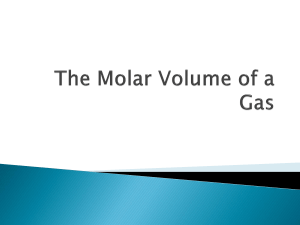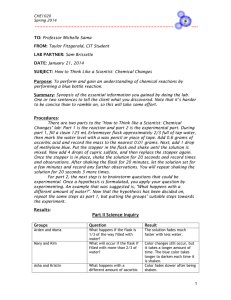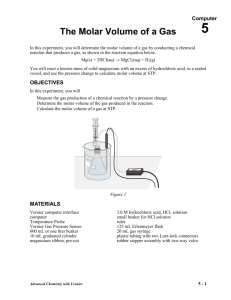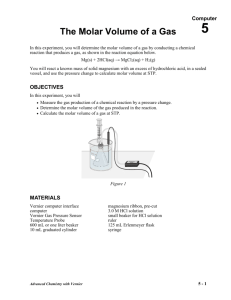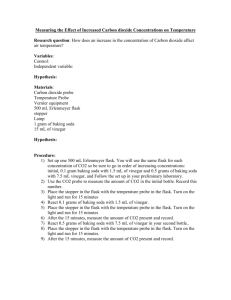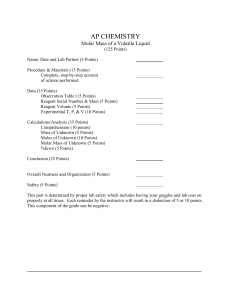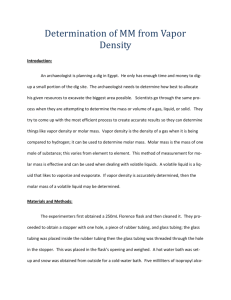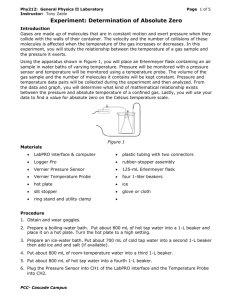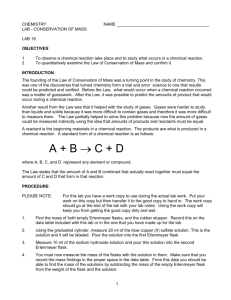prelab
advertisement
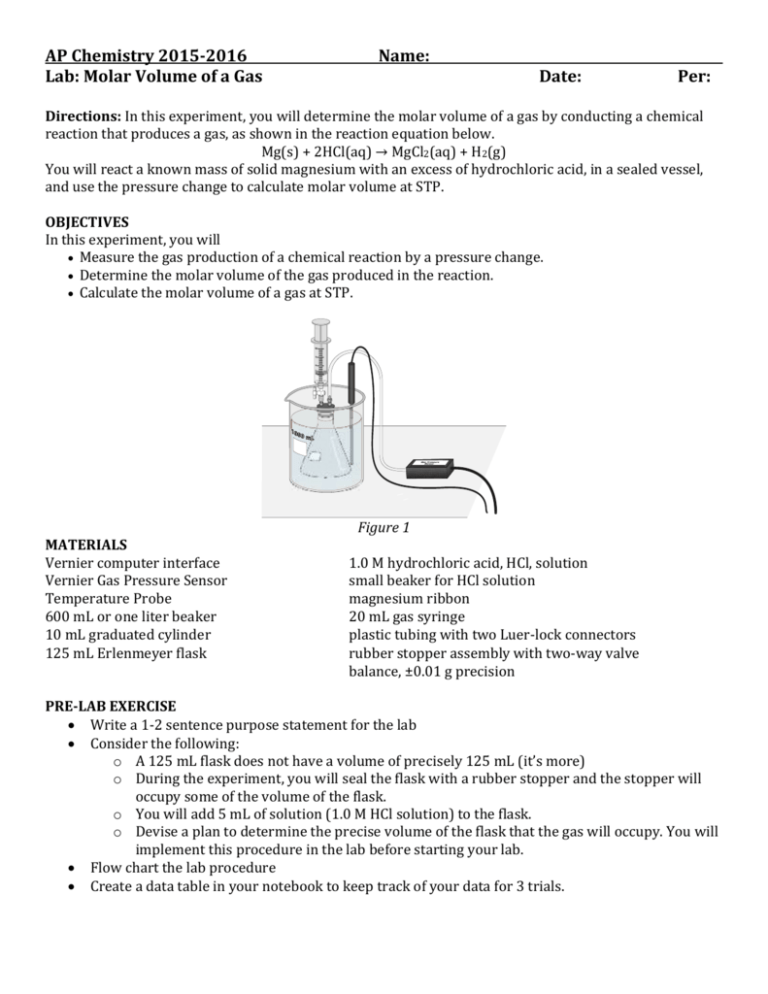
AP Chemistry 2015-2016 Lab: Molar Volume of a Gas Name: Date: Per: Directions: In this experiment, you will determine the molar volume of a gas by conducting a chemical reaction that produces a gas, as shown in the reaction equation below. Mg(s) + 2HCl(aq) → MgCl2(aq) + H2(g) You will react a known mass of solid magnesium with an excess of hydrochloric acid, in a sealed vessel, and use the pressure change to calculate molar volume at STP. OBJECTIVES In this experiment, you will Measure the gas production of a chemical reaction by a pressure change. Determine the molar volume of the gas produced in the reaction. Calculate the molar volume of a gas at STP. MATERIALS Vernier computer interface Vernier Gas Pressure Sensor Temperature Probe 600 mL or one liter beaker 10 mL graduated cylinder 125 mL Erlenmeyer flask Figure 1 1.0 M hydrochloric acid, HCl, solution small beaker for HCl solution magnesium ribbon 20 mL gas syringe plastic tubing with two Luer-lock connectors rubber stopper assembly with two-way valve balance, ±0.01 g precision PRE-LAB EXERCISE Write a 1-2 sentence purpose statement for the lab Consider the following: o A 125 mL flask does not have a volume of precisely 125 mL (it’s more) o During the experiment, you will seal the flask with a rubber stopper and the stopper will occupy some of the volume of the flask. o You will add 5 mL of solution (1.0 M HCl solution) to the flask. o Devise a plan to determine the precise volume of the flask that the gas will occupy. You will implement this procedure in the lab before starting your lab. Flow chart the lab procedure Create a data table in your notebook to keep track of your data for 3 trials. PROCEDURE 1. Obtain and wear goggles. 2. Obtain a ~0.010 g piece of magnesium ribbon. Measure and record its mass to the nearest 0.01 g. Place the piece of magnesium ribbon in a clean and dry 125 mL Erlenmeyer flask. 3. Prepare a room temperature water bath in a large beaker. The bath should be deep enough to completely cover the gas level in the Erlenmeyer flask. 4. Connect a Gas Pressure Sensor to Channel 1 of the Vernier computer interface. Connect a Temperature Probe into Channel 2 of the interface. 5. Use the clear tubing to connect the white rubber stopper to the Gas Pressure Sensor. (About one-half turn of the fittings will secure the tubing tightly.) Twist the white stopper snugly into the neck of the Erlenmeyer flask to avoid losing any of the hydrogen gas that will be produced in the reaction (see Figure 1). Important: Close the valve on the white stopper by turning the white handle so it is perpendicular with the valve stem. 6. Obtain a small amount of 1.0 M hydrochloric acid. CAUTION: Handle the hydrochloric acid with care. It can cause painful burns if it comes in contact with the skin. Draw 5 mL of HCl solution into the 20 mL syringe. Thread the syringe onto the two-way valve on the white stopper (see Figure 1). Submerge the Erlenmeyer flask into the water bath. Position the Temperature Probe in the water bath so that the tip of the probe is not touching the beaker. 7. On your interface, you should now see readings for both pressure and temperature. Record your initial pressure and temperature. 8. With the flask still submerged in the water bath, open the two-way valve directly below the syringe, press the plunger to add all of the 5 mL of HCl solution to the flask and pull the plunger back to its original position. Close the two-way valve. 9. Keep the flask immersed in the water bath as the reaction proceeds. Keep an eye on your pressure and temperature data – you want to take note of your maximum pressure and average temperature. 10. Once the reaction is complete, carefully remove the white stopper from the flask to relieve the pressure in the flask. Important: Do not open the two-way valve to release the pressure in the flask. 11. Rinse, clean, and dry the flask for a second trial. Obtain a new piece of magnesium ribbon and place it in the flask. Repeat the necessary steps to conduct the second trial. 12. Follow the same procedure to conduct a third trial. DATA TABLE Trial 1 Trial 2 Trial 3 Mass of Mg (g) Volume of flask (mL) Maximum pressure (kPa) Initial pressure (kPa) Pressure change, ∆P (kPa) Temperature (K) DATA ANALYSIS 1. Calculate the moles of each piece of magnesium ribbon that you used. 2. Calculate the molar amount of hydrogen gas that was produced in your reactions. 3. Calculate the volume of one mole of hydrogen gas (molar volume) at STP. CONCLUSION Compare your calculated molar volume, at STP, with the accepted molar volume of an ideal gas at STP, 22.4 L/mol. If the values do not compare well, suggest possible sources of experimental error.
